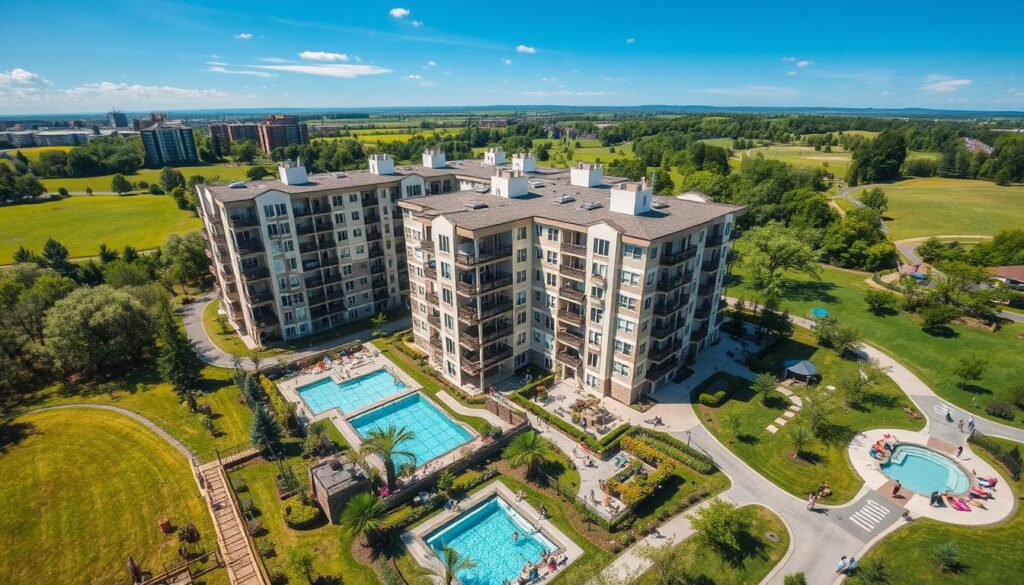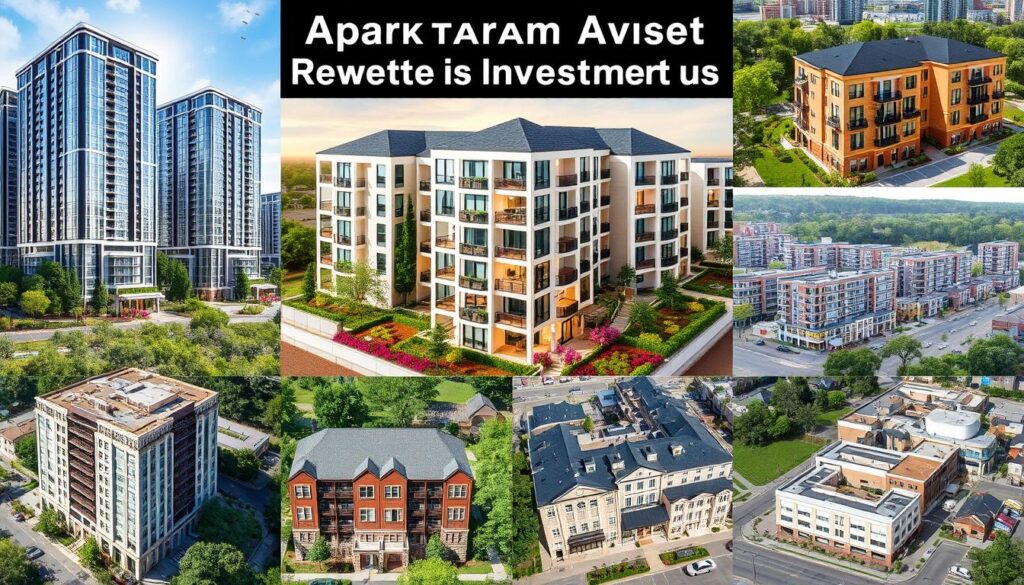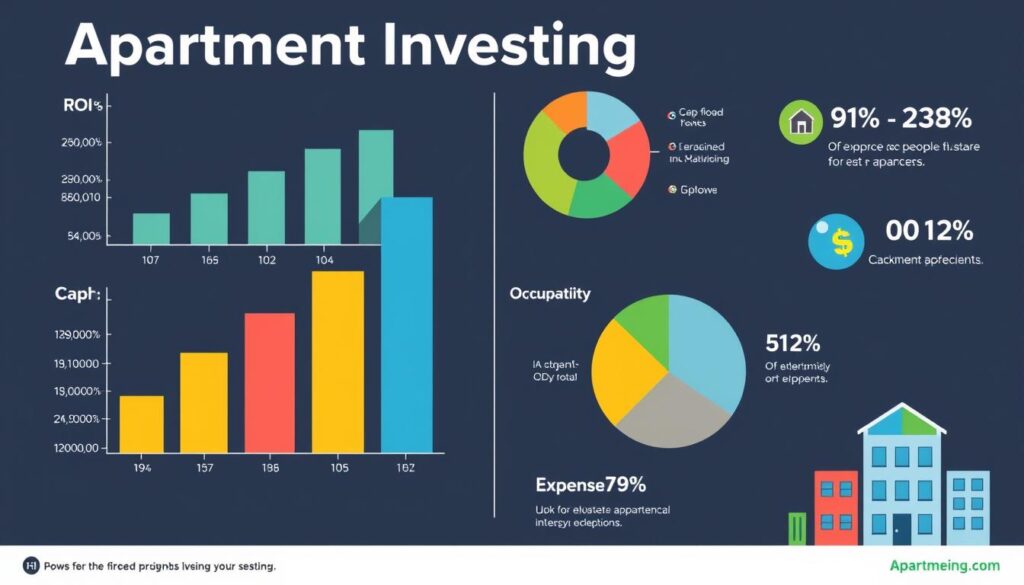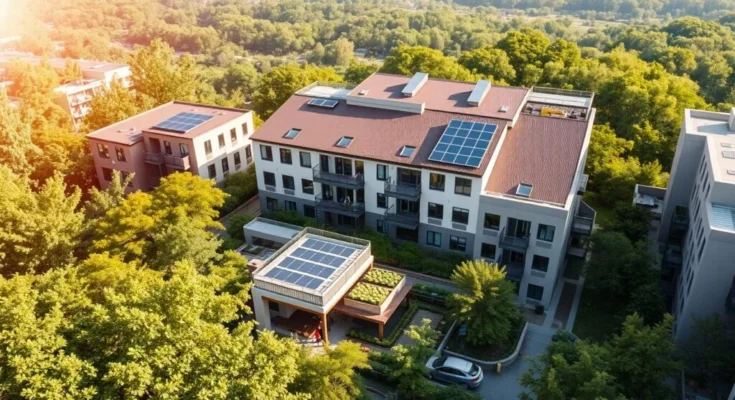How to Invest in Apartment Complexes? The Investing in apartment complexes can be a great way to grow your money and earn regular income. But getting started can feel tricky. Here’s a simple guide to help:
- Learn the Basics – Understand what apartment complex investments are and how they work.
- Check Your Budget – Figure out how much you can afford to invest.
- Explore Financing Options – Look into loans or other ways to fund your purchase.
- Choose the Right Location – Find areas where people want to live.
- Research the Market – Check rental demand and potential profits.
- Plan for Management – Decide if you’ll manage the property yourself or hire a company.
With these steps, you can start your journey to investing in apartment complexes and building a strong investment portfolio!

Key Takeaways
- Apartment complex investing can provide stable and diverse income streams.
- Understanding the unique aspects of multifamily property investment is crucial.
- Strategic planning in identifying your investment goals is essential.
- Market knowledge plays a vital role in successful investments.
- Choosing the right financing options can affect your investment’s profitability.
- Best practices involve thorough research and assembling a reliable team.
Understanding Multifamily Property Investment
Investing in multifamily properties can be a smart move for both new and experienced investors. There are many types of properties, like duplexes and big apartment buildings. Each type has its own benefits and challenges to consider.
What is Multifamily Property?
A multifamily property is a building that houses many families or individuals in separate homes. These can be small duplexes or huge apartment buildings with lots of units. Knowing about these different types helps you find the right property for your investment.
Benefits of Investing in Multifamily Properties
Investing in multifamily properties has many perks. For one, you can earn more money because you have many tenants paying rent. Other benefits include:
- Economies of scale, which lower management costs per unit.
- Lower risk because you have a diverse group of tenants, making your income more stable.
- Tax benefits, like depreciation, which can increase your returns.
These advantages make multifamily properties a great choice for real estate investors.
| Property Type | Unit Count | Typical Features | Investment Potential |
|---|---|---|---|
| Duplex | 2 | Single building, two separate units | Moderate |
| Triplex | 3 | Single building, three separate units | Moderate to High |
| Fourplex | 4 | Single building, four separate units | High |
| Apartment Complex | 5+ | Multi-story buildings, various unit types | Very High |
How to Invest in Apartment Complexes
Investing in apartment complexes is a big step towards your financial goals. First, you need to know what you want. This could be steady income or watching your property value grow over time. Having clear goals is key. Read More 9 Easy Ways to Start Investing in Apartment Buildings (2024)
Identifying Your Investment Goals
Your goals should match your financial situation and how much risk you can handle. Think about these:
- Do you want quick profits or are you in it for the long haul?
- How much risk are you okay with?
- Do you want to manage the property yourself or not?
These questions help you find the best investment plan for you.
Understanding the Market
Knowing the market is crucial for success. Start by looking at:
- What’s happening with property prices and where people want to live.
- Changes in the area’s population and how it affects rentals.
- Similar properties to see what they’re worth and what you might make.
By getting this information, you make better choices. This ensures your investment meets your goals.

| Investment Goals | Characteristics | Potential Strategies |
|---|---|---|
| Passive Income | Steady cash flow, low involvement | Buy-and-hold, rental properties |
| Long-Term Appreciation | Increase in property value over time | Value-add strategy, redevelopment |
| Flipping | Quick profit from renovations and resale | Fix-and-flip, market timing |
Types of Apartment Complex Investments
When looking at apartment complex investments, it’s key to think about who you want to rent to and your investment plan. The world of apartment investments changes a lot based on the market, the type of property, and what tenants need. Knowing these areas helps you make choices that fit your financial goals.
Luxury vs. Affordable Housing
Luxury apartments draw in people with high incomes who want top-notch amenities and great locations. They often have fancy facilities, concierge services, and better security. This means they can charge more rent and make good money.
On the other hand, affordable housing is for people who don’t spend a lot on rent. It’s about providing basic living spaces at lower prices. Investing in affordable housing meets a big social need and usually has steady demand.
Garden-Style vs. High-Rise Apartments
Garden-style apartments are low-rise buildings with lots of green space around them. They help people feel connected through shared outdoor areas and things like pools or playgrounds. High-rise apartments, on the other hand, are for city lovers who like modern designs and saving space.
High-rise apartments might make more money, but they can also have more empty units and higher upkeep costs. It’s important to understand these differences when picking what apartment investments to make.

| Investment Type | Target Tenant | Property Features | Expected Returns |
|---|---|---|---|
| Luxury Apartments | High-Income Earners | Premium amenities, concierge services, prime locations | High |
| Affordable Housing | Budget-Conscious Residents | Basic amenities, lower rental prices | Stable |
| Garden-Style Apartments | Families, Community-Oriented Tenants | Outdoor spaces, community amenities | Moderate |
| High-Rise Apartments | Urban Dwellers | Modern design, compact living spaces | Variable |
How to Analyze Potential Apartment Investments
When looking at apartment investments, knowing a few key metrics is crucial. These metrics are the base for making investment decisions. They help you see if a property is a good choice.
Key Metrics to Consider
Several important metrics are key in apartment investing. Learning about these metrics improves your analysis. It helps you make better investment choices. Key metrics include:
- Capitalization Rate (Cap Rate): This shows the expected yearly return on investment. It’s based on the property’s net operating income.
- Cash-on-Cash Return: This metric shows the return on your cash investment. It helps you understand your investment’s cash flow better.
- Operating Expenses: Looking at operating expenses helps spot any financial issues. It also shows the property’s cash flow.
Evaluating Location and Amenities
Success in investing isn’t just about numbers. The location and amenities also play a big role. Consider these factors:
- Proximity to Schools: Families want apartments near good schools. This makes these properties more attractive.
- Access to Public Transportation: Easy access to public transport attracts a wide range of tenants. This boosts your investment’s appeal.
- Employment Opportunities: Apartments near major job centers usually have higher occupancy rates.

Apartment Building Investment Strategies
Knowing about different ways to invest in apartment buildings can really help. Two main strategies are value-add investing and the buy-and-hold strategy. Each has its own benefits, fitting different investment goals and risk levels.
Value-Add Investing
Value-add investing is about buying properties that need work. Investors look for ways to make the property better through renovations or better management. This can increase rental income and property value over time. It requires careful planning and enough money for renovations.
Buy-and-Hold Strategy
The buy-and-hold strategy is about keeping properties for a long time. Investors want to make money from steady rental income and property appreciation. This method reduces the stress of constantly buying and selling properties. It offers stability and predictable income.
| Investment Strategy | Key Features | Potential Benefits | Challenges |
|---|---|---|---|
| Value-Add Investing | Focuses on renovation and improvement of existing properties | Higher rental income, improved property value | Requires significant upfront investment and project management |
| Buy-and-Hold Strategy | Acquisition for long-term rental income and appreciation | Steady cash flow, lower turnover costs | Market fluctuations can impact property value |
Securing Financing for Your Apartment Investment
Investing in apartment complexes needs a good grasp of financing options. The right loan can help with upfront costs and shape your investment plan. Looking into different financing ways helps you use your resources well and grow a profitable portfolio.
Types of Financing Options Available
There are many financing options for apartment complexes. Each has its own benefits and needs:
- Conventional Loans: Banks and credit unions offer these. They need a good credit score and a big down payment.
- FHA Loans: These government-backed loans are for those with lower credit scores. They require a small down payment, making it easier to start.
- Private Financing: Non-traditional lenders provide funds with flexible terms. This is good for those who need a quick approval.
- Commercial Loans: These loans are for real estate investments. They have different interest rates and terms based on the property’s income.
Working with Lenders and Mortgage Brokers
Building good relationships with lenders and mortgage brokers is key. A connected broker can show you financing options that fit your finances. Knowing how to work with them can get you better rates and a smoother process:
- Research Lenders: Look for those with experience in multifamily properties.
- Gather Financial Documents: Having all the right info makes the application easier.
- Negotiate Terms: Talk about interest rates, fees, and repayment plans to fit your strategy.
Best Practices for Apartment Complex Investing
To succeed in apartment complex investing, it’s key to know and follow the best practices. This means doing thorough research and working with a reliable team. Each step is crucial for making smart choices and lowering risks in multifamily investments.
Conducting Thorough Due Diligence
Due diligence is the foundation of successful apartment investments. It involves several important steps:
- Doing detailed property checks to spot any structural or maintenance problems.
- Looking into the local real estate market to understand demand and prices.
- Examining financial documents like profit and loss statements to see how the property is doing financially.
By carefully checking these areas, you can make your investments profitable and avoid unexpected issues.
Assembling a Reliable Team of Professionals
Apartment complex investing is complex and needs a team of experts. Important team members include:
- Real Estate Agents: They offer insights and help pick properties.
- Property Managers: They manage the property well and keep tenants happy.
- Legal Advisors: They help with laws and contracts.
Having a solid team boosts your investment plan. It also brings in valuable knowledge to help reach your goals.
Passive Income from Real Estate
Investing in apartment complexes can lead to passive income. This way, you earn money with little effort. Learning how to create and use passive income streams is key to a successful investment.
Benefits of Passive Income Streams
Passive income offers more than just money. By investing in multifamily properties, you get a steady income from rent. This stability lets you invest in other opportunities or save for the future.
It also gives you more freedom in your life. You don’t have to rely on just one job for money.
Tax Advantages of Multifamily Investments
Investing in multifamily properties has tax perks. You can deduct a lot, like depreciation and repairs. These deductions lower your taxable income, making your investment more profitable.
Knowing how to use these tax benefits can boost your returns. It helps improve your financial health.
Current Trends in Apartment Investing
Knowing the latest trends in apartment investing is key to smart choices. Changes in demographics, more people living in cities, and a focus on green living shape the market. It’s crucial for investors to keep up to stay ahead.
Market Trends and Their Impact
The multifamily housing market is changing fast. Younger people wanting to rent in cities have raised demand for urban living. Also, more people working from home are moving to suburbs, mixing traditional apartments with flexible living options.
- Urbanization: Cities are growing, drawing in people from all walks of life.
- Sustainability: Green building and materials are now a must for new projects.
- Affordability: With housing costs going up, finding affordable options is key for investors.
Tech Innovations Influencing Multifamily Investing
Technology is changing how we connect with tenants and manage properties. New tools like property management software make things easier. They help with communication and service. Virtual tours and digital marketing also help attract renters.
| Technology | Description | Impact on Investment |
|---|---|---|
| Property Management Software | Streamlines operations, managing everything from leases to maintenance requests | Enhances operational efficiency |
| Virtual Tours | Allows prospective tenants to view properties remotely | Improves tenant acquisition |
| Smart Home Technology | Integrates smart devices for security, energy efficiency, and convenience | Increases property value and attractiveness |
Common Mistakes to Avoid in Apartment Complex Investing
Investing in apartment complexes can be very profitable. But, many new investors make mistakes that can hurt their success. Knowing the common mistakes helps you avoid them.
Overlooking Research and Due Diligence
One big mistake is not doing enough research. Not researching well can lead to big financial losses. Investors often don’t think about repair costs, neighborhood issues, or market trends.
Doing thorough research is key. Look into these things before you invest:
- Local market trends
- Comparable rental prices
- Historical vacancy rates
- Future development plans in the area
Ignoring Property Management Needs
Another big mistake is not paying attention to property management. Some think they can do it all by themselves. But, good property management keeps tenants happy and helps keep the property full.
Managing maintenance, talking to tenants, and handling emergencies are important. They need your focus.
ROI in Apartment Complexes: What You Need to Know
Understanding ROI in apartment complexes is key to making the most of your investment. You need to accurately calculate return on investment to see if your property is profitable. Several factors affect your ROI, like cash flow, property value increase, and tax benefits. Knowing these can help you make smart investment choices.
Calculating Your Return on Investment
To figure out ROI in apartment complexes, use a simple formula. It looks at your initial investment and ongoing earnings. The steps to calculate return on investment are:
- Find out your purchase price and initial costs
- Calculate the annual income from rent
- Subtract expenses like maintenance and property management fees
- Include property value growth over time
This detailed method helps you understand your expected earnings. It guides you to make profitable choices.
Long-Term vs. Short-Term Investment Strategies
Your investment strategy greatly affects ROI in apartment complexes. Short-term and long-term strategies differ in their goals and methods:
| Strategy Type | Characteristics | Benefits |
|---|---|---|
| Short-Term Strategies | Focus on quick sales or flips | Rapid cash flow and high immediate returns |
| Long-Term Strategies | Emphasize holding properties for appreciation | Stable income and compounded value growth |
Choosing the right strategy depends on your financial goals and risk level. Matching your strategy with your goals can greatly impact your success in multifamily investing.
Conclusion
Investing in apartment complexes can be very profitable. We’ve looked at different ways to invest in multifamily properties. This includes setting your goals and understanding market trends.
It’s crucial to do your homework and get help from experts. This way, you can handle the challenges of the multifamily market better.
Investing in apartments offers steady income, tax benefits, and the chance for property value to grow. These benefits can make your finances stronger and build a valuable asset. Think about the strategies we’ve talked about to choose the best one for you.
Success in multifamily investing needs careful planning and smart choices. Keep learning and making informed decisions. Your smart actions now can lead to big wins in the multifamily real estate market later.
FAQ
What are the best practices for apartment complex investing?
For apartment complex investing, start with thorough research and understanding the local market. It’s also key to have a reliable team of professionals. Always analyze potential investments carefully, looking at both financials and management needs.
How do I calculate ROI in apartment complexes?
To find your ROI in apartment complexes, look at cash flow, property value increase, and tax benefits. Use the formula: (net profit / total investment) * 100. This gives you a percentage.
What financing options are available for apartment complex investments?
There are many financing options for apartment complex investments. These include conventional loans, FHA loans, private financing, and hard money loans. Each has its own criteria and benefits. Choose the one that fits your investment plan best.
What are common mistakes to avoid in apartment investing?
Don’t overlook the importance of research and due diligence in apartment investing. Also, don’t ignore property management needs or market conditions. These mistakes can lead to financial loss and hinder success.
What are some effective apartment investing strategies?
Effective strategies include value-add investing and the buy-and-hold approach. Value-add investing means improving properties to increase their value. The buy-and-hold strategy involves keeping properties for long-term appreciation and rental income.
How do I find apartment investment opportunities?
To find apartment investment opportunities, network with real estate agents and attend industry events. Also, use online platforms for multifamily property listings. Keeping up with market trends helps spot emerging opportunities.
What tax advantages come with multifamily investments?
Investing in multifamily properties offers tax benefits like depreciation deductions. These deductions can reduce taxable profits. You can also write off expenses for property management and maintenance.
What trends should I be aware of in apartment investing?
Stay updated on trends like sustainability, urbanization, and technology’s impact on property management. Knowing these trends helps you adjust your strategy for better results.




